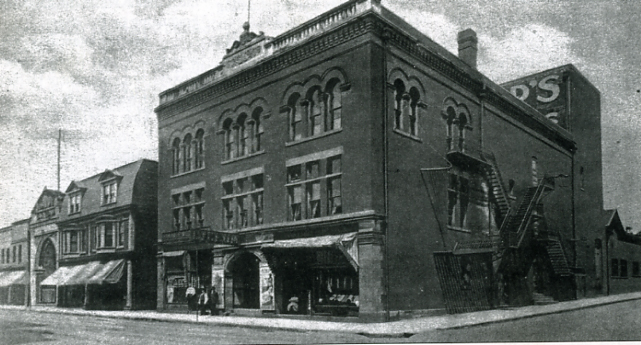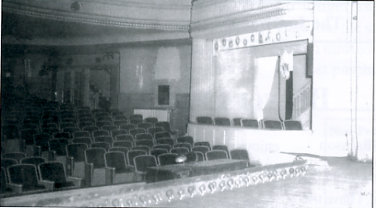
The Lyceum Theater (on the right) and Savoy Theater
(on the left) were two early theaters in Beaver Falls.
Click Here to Return to Milestones
In this article, I have tried to recreate for
you, the reader, the entire history of the Beaver Falls theater.
In putting into words this information I have tried to keep the
events in the chronological order, although in some instances
it has been impossible because there are no definite records.
I sincerely hope that you enjoy reading this article as much as
I have enjoyed writing it.

According to medicine, man needs, among other things, entertainment.
Looking over the history of Beaver Falls, I found that the city
was founded in 1868, and about ten years later obtained their
first theater. This goes to show that apparently my first statement
is correct.
The Waxworks made its debut to this city during the late 1870s.
Wax models provided entertainment for many viewers.
During this same period of time the Wagnor's Hall opened. This
theater occupied only the third floor (pity whoever might be on
the second) of the building on Sixth-Avenue and Fifth Street.(1)
Here stage shows were the main attraction, although other entertainment
was provided.
Shortly thereafter, C.B. Foster opened the Foster Opera House.
(2) Having been built originally for skating it was later used
for stage shows.
In 1892, another skating rink opened. Three years later it met
the same fate (or fortune) as the other. Located on the northwest
corner of Sixth Avenue and Seventh Street, it was called the Sixth
Avenue Theater.
Although its name was not the most glamorous, the Sixth Avenue
Theater was heralded as being the "most illustrious theater
in Western Pennsylvania."
There are, perhaps, several reasons for this. I shall try to give
you but a few of them.
Instead of just one form of entertainment several different types
were presented. The annual "Peg leg Ball," wrestling,
skating, six day walking and bicycle races, church fairs and festivals,
dancing, polo, and hockey (after 1902) were a few of them.
Besides this it was also the largest theater in the county (3).
I guess the outstanding feature of this theater was its floor.
Until this time the floors had no incline thus making it difficult
to view all the proceedings. Evidently Frederick G. Rohrkaste,
the owner, had this thought in mind when he bought several huge
slabs. If he needed an inclined floor, these slabs were laid;
if he wanted it flat, they were removed. In fact at one high school
commencement, the false floor in the rear was being removed for
a post commencement dance while the class was graduating on the
stage.
Another interesting event was that a part of the famed Coxey's
army slept here on their march to Washington, D.C.
The "Mikado", and "Ten., Twent, Thirt" were
but two of the many never-to-be-forgotten shows.(4)
Illustrious as the Sixth Avenue Theater was, still their prices
remained low. Floor admission was 30 cents; the side gallery 20
cents; and the gallery 10 cents. (5)
Included in the number of prominents who appeared here were George
M. Cohan, the Sousa Band, the Gillmore Band and the Reverend T.
DeWitt Talmadge.
After 1902, the Sixth Avenue Theater failed rapidly.(6) Hockey
and skating were added to the agenda, but these attempts did not
save this house.
In 1911 this building was razed . . . its glory and fame are no
longer remembered. In their place are only the vivid memories
of the colorful Sixth Avenue Theater.
On December 29, 1902, the Hanaver Enterprises opened the new Lyceum
Theater. Located in the center of town, the Lyceum presented stage
shows for the customer's enjoyment. (7)
Although somewhat delayed (8) Rice's "Show Girl" greeted
the opening night crowd. Neither the vicious weather nor the outrageous
prices of $50 per box for box seats and $1.50 for the remaining
orchestra seats stopped an opening night sellout.
Some stars of greater importance who performed on the Lyceum's
stage were Eva Tanguay, Emma and Johnny Ray (not our present singing
Johnny Ray), George Sidney, and Marie Wainwright, Stella Mayhew,
Madame Nordica with the Duss Band (9), and Amelia Bingham.
A few of the better known plays presented were "King Dodo
and Miss Bob White". "The Time, the Place, and the Girl"
(10), "As You Like It". "The Lady and the Prince".,
and "Wang". After DeWolf Hopper performed in "Wang,"
he recited "Casey At the Bat" for a delighted audience.
"The Awakening of Mr. Pipp" (11) and "Our New Minister"
are still regarded as the funniest shows ever presented on the
Lyceum's stage.
It was not much later that John J. Paff, built the Alhambra Theater.
It was located in the upper end of town and usually presented
vaudeville.
In quick succession the Grand, Comet, Star, and Ev-Ash were built.(12)
These four theaters were located between Tenth Street and Twelfth
Street on Seventh Avenue.
It was not too much later that permission was asked of the city
officials to build a frame construction on Seventh Avenue between
Eleventh Street and Twelfth Street.(13) The permission was granted
for a period of 90 days; then the building was to be removed.
However, the ground on which the structure was erected had been
leased, therefore at the end of the ninety days the owner closed
the building; but the landowner refused to have it removed saying
that he had not made such an agreement. This was the way in which
Beaver Falls first obtained the Colonial Theater, which a few
years later was remodeled and renamed the New Colonial.
The New Colonial was much like the others during this period,
being principally a vaudeville house.
The Savoy Theater, which was just three doors from the Lyceum,
debuted in 1907. This theater offered an exclusive policy of presenting
only vaudeville and stage shows. The Hanaver Enterprises also
operated this house.

The Grand, Comet, Star, and Ev-Ash, had existed for only a short
time. (14)
In 1927, the Lyceum Theater closed for a complete renovation,
including a change of name.
On October 22, 1928, the newly remodeled Rialto opened. The 900
seat house now presented silent pictures and occasionally a few
stage shows. (15)
In the early 1930s sound was added in this theater.
The best remembered stage shows were the Elk's Minstrels, the
last of which was presented in 1935
In June of 1951, the Rialto left its straight motion picture policy
to present the Miss Beaver Valley Contest.(16)
The Rialto, which is now under the management of Robert Higgens,
is considered by many to be the leading theater in Beaver Falls.

The Regent has a seating capacity of 1,150.(17) Although it formerly
had a second balcony, it now has only the one. (18) This theater
presents most of the action pictures such as cowboy and mystery
thrillers.


In the early 1930's the manager of the New Colonial ran a contest
to name the remodeled house. The winning name was Granada, and
to this day it has been retained.
The Rialto and Granada are both first run houses and bring pictures
of high standing to the city.
During the late 1930s the Savoy Theater was razed and a parking
lot was made for the Rialto's customers.
However, a few years later the State was erected on this site
and opened on November 17, 1940.
Because of severe competition from drive-ins and television, the
State was closed during the summer of 1951. Upon reopening in
the fall it presented an entirely new policy by running movies
such as "A Streetcar Named Desire", "Oliver Twist".
and "The Lavender Hill Gang."(19)
Although Beaver Falls had four theaters operating, apparently
they did not wish to be behind, the rest of the country. On May
1, 1948, the first drive-in-theater in the Beaver Falls area opened.
It's name was Hi-Way 51, and the responsible men were Albert Tate
and John Wincek.
This theater, which is located about six miles from the city on
Route 51, like other drive-ins, plays second run features.
On June 14, 1948, Joseph Borderaro and Ralph Felton opened the
Spotlight 88 theater. Located at the intersection of Routes 88
and 163, it also plays second run features.
Both of these drive-ins have done much to promote their own business.
While Spotlight 88 has added a few novelty rides for the kiddies,
Hi-Way 51 features an entire kiddies playground. Both of them
have also succeeded in copping a few first run pictures, evidently
proving that drive-ins are taking their place in the entertainment
world. (20)
Presently these six theaters- Rialto, Regent, Granada, State,
Hi-Way 51 and Spotlight 88-are all operating.
The theaters of Beaver Falls provide for the public a wide and
varied program; if you miss a picture or if you would like to
see one over, as is sometimes the case, it is sure to play one
of the drive-ins.
All of these theaters maintain up to date methods of projection,
which adds to the enjoyment of a movie. With a combined seating
capacity of approximately 6,230, this city can well look forward
to having the best in movie entertainment brought to their town.

1. It was located directly across Sixth Avenue
from Solomon's
swimming pool.
2. Foster's Opera House was located on the site of our present
Post Office. (Facing Eleventh Street Between Seventh and Eighth
Avenue.)
3.Twenty sets of square dancers could dance there at once.
4. MIKADO was the opening night show.
5.These prices were for repertoire shows; others ran a few cents
higher.
6.I believe this was due to the newer, more modern Lyceum. (discussed
later)
7. The population was below Seventh Avenue Hill; the Lyceum was
on Seventh Avenue and Fifth Street.
8. Train was delayed and the show did not begin till nine o'clock.
9. The Duss Band was led by the late John Duss of Old Economy.
10. This play starred a local man, George Ebner.
11. Charley Grapewin was starred in this production.
12. The Ev-Ash received its name from the owners Charlie EVerest
and Al ASHenbaugh.
13. The city ordinance provides that no frame buildings are to
be constructed on Seventh Avenue.
14. I believe this was due to their being so close. Besides that,
the population was not great enough that seven theaters could
exist at the same time.
15. This was located where the old Lyceum theater was. (Fifth
Street and Seventh Avenue.)
16. This is run for the Miss America Pageant Officials.
17. The Regent is the former Alhambra.
18. The second balcony has since been converted into a projection
room.
19. These pictures are usually second run and are brought back
by public demand.
20. Hi-Way 51 was the first to do this in 1950.